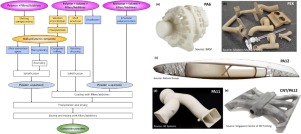Progress in Polymer Science ( IF 27.1 ) Pub Date : 2018-11-07 , DOI: 10.1016/j.progpolymsci.2018.11.001 Shangqin Yuan , Fei Shen , Chee Kai Chua , Kun Zhou

|
As one of the most important categories in the additive manufacturing (AM) field, powder-based techniques, such as selective laser sintering, electron beam melting and selective laser melting, utilize laser or electronic beams to selectively fuse polymeric, metallic, ceramic or composite powders layer-by-layer into desired products according to their computer-aided design models. With unique mechanical, thermal, electrical, biocompatible and fire-retardant properties, polymeric composite materials for powder-based AM have been attracting intensive research interests because of their potential for a wide variety of functional applications in aerospace, automobile, marine and offshore, medical and many other industries.
This article provides a comprehensive review of the recent progress on polymeric composite materials, their powder preparation for AM, and functionalities and applications of their printed products. It begins with the introduction of thermoplastic polymers that have been used as the main matrices of the polymeric composites and various composite reinforcements such as metallic, ceramic, carbon-based fillers and polymer blends for strengthening and functionality purposes. Discussion is then made on the processes for manufacturing such polymeric composites into powder form, which include shear pulverization, solution-based methods and melt compounding methods, with a focus on their advantages, limitations and challenges in terms of their productivity and processibility as well as powder printability. Thereafter, the properties and functionalities of the printed products and their various intriguing applications particularly in biomedical (anatomical models, tissue engineering and drug delivery), aerospace, automobile, military, energy and environmental, acoustic devices and sports equipment are highlighted. Finally, this review is concluded with an outlook on polymeric composites for powder-based AM, new opportunities, major challenges and possible solutions.
中文翻译:

粉末基增材制造的聚合物复合材料:材料和应用
作为增材制造(AM)领域中最重要的类别之一,基于粉末的技术(例如选择性激光烧结,电子束熔化和选择性激光熔化)利用激光或电子束选择性地熔化聚合物,金属,陶瓷或复合材料根据其计算机辅助设计模型将粉末逐层粉化为所需产品。粉末状增材制造的聚合物复合材料具有独特的机械,热,电,生物相容性和阻燃性能,因其在航空航天,汽车,船舶和海上,医疗等领域的广泛功能应用潜力而吸引了广泛的研究兴趣。和许多其他行业。
本文全面回顾了聚合物复合材料,用于AM的粉末制备以及其印刷产品的功能和应用方面的最新进展。它从引入热塑性聚合物开始,该热塑性聚合物已被用作聚合物复合材料的主要基质,以及各种复合材料增强材料,例如金属,陶瓷,碳基填料和用于增强和功能性目的的聚合物共混物。然后讨论了将这种聚合物复合材料制成粉末形式的方法,包括剪切粉碎,溶液基方法和熔融混料方法,重点是它们在生产率和可加工性方面的优势,局限和挑战以及粉末可印刷性。之后,重点介绍了印刷产品的特性和功能,以及它们在各种有趣的应用中的应用,特别是在生物医学(解剖模型,组织工程和药物输送),航空航天,汽车,军事,能源和环境,声学设备和运动器材中。最后,本综述以对粉末基增材制造的聚合物复合材料的展望,新机遇,重大挑战和可能的解决方案作了总结。



























 京公网安备 11010802027423号
京公网安备 11010802027423号